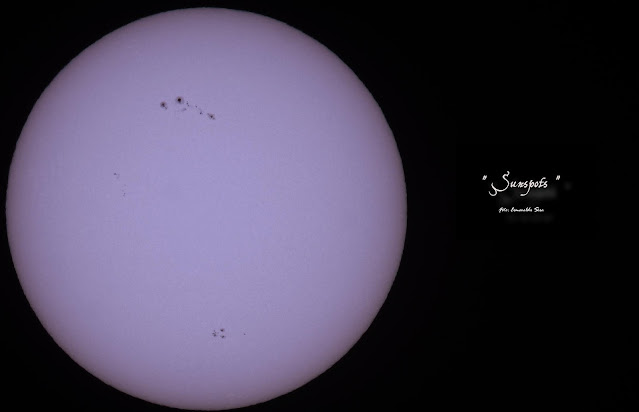.. 11.30am ..
Marcada en rojo por ser una región muy activa.
Presenta una probabilidad del:
85% de erupciones de tipo C
25% de erupciones de tipo M
1% de erupciones de tipo X
Las erupciones solares se clasifican con las letras A, B, C, M, X según el flujo máximo de rayos X ( medidos en las inmediaciones de la Tierra ), con longitudes de onda de 0.1 a 0.8 nanómetros.
Cada clase tiene un pico de flujo 10 veces mayor que el anterior.
Una erupción de tipo C tiene un pico de flujo 10 veces mayor que una de clase B y 100 veces mayor que una de clase A.
Dentro de cada clase se define una escala lineal del 1 al 9.
Una C2 tiene un pico de flujo 2 veces mayor que una C1.
Una C3 tiene un pico de flujo 3 veces mayor que una C1.
Una C9 tiene un pico de flujo 9 veces mayor que una C1.
Una M1 tiene un pico de flujo 10 veces mayor que una C1.
Una M2 tiene un pico de flujo 20 veces mayor que una C1.
M1 = 10 C1
M2 = 2 M1 = 2 *10 C1 = 20 C1
SERIE DE FOTOGRAFÍAS QUE MUESTRAN LA EVOLUCIÓN DE LA REGIÓN 3288
En la región inferior derecha se muestran los tamaños comparativos de la Tierra y Júpiter con el Sol, observar que algunas de las manchas contendría perfectamente a la Tierra.
25 de abril del 2023
26 de abril del 2023
27 de abril del 2023
28 de abril del 2023
29 de abril del 2023
info: Licenciado en Física José Luis Lomáscolo
A DANGEROUS SUNSPOT
Big sunspot AR3288 has an unstable 'delta-class' magnetic field that harbors energy for powerful X-class solar flares. If such an explosion does occur today, it will be geoeffective. The sunspot is almost directly facing Earth.
Pepe Manteca has been watching the sunspot from Begues, Spain: "Today, region AR3288 has emitted 4 C-class solar flares. I was fortunate to be able to capture this C8.8-class explosion from beginning to end."
"It was very exciting!" he says.
Compared to the X-flares AR3288 is capable of unleashing, these C-flares are minor and weak. A steady diet of weak may be draining energy from the active region, preventing it from unleashing the Big One. Amateur astronomers with solar telescopes are encouraged to monitor developments. As Manteca's photos show, even "weak" flares can be very photogenic.
PARA VER FOTOS EN HD ABRIR SIGUIENTE LINK (FOTOS: ESMERALDA SOSA )
https://drive.google.com/drive/folders/1Oiz25tISsTfiXhCCRfLz_VYmA270HV3x?usp=sharing







.png)
.png)
.png)
.png)





No comments:
Post a Comment